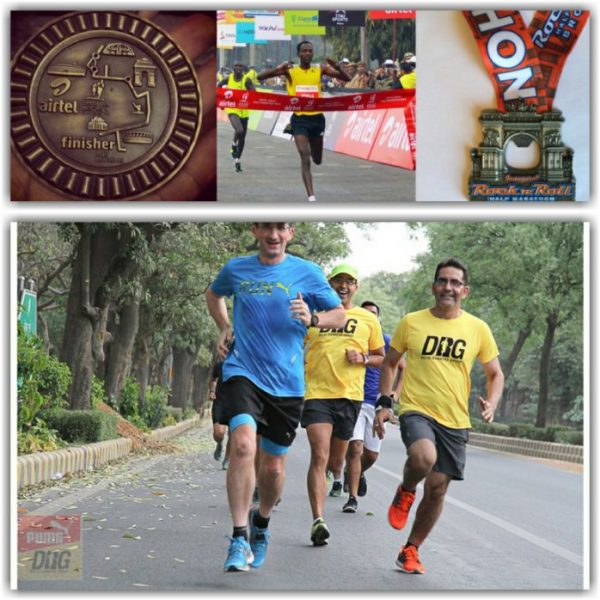The obsession with running is really an obsession for achieving more and more with life !
Bottom line up front – The ability to run with sustained speed is the key to achieving a personal best time in a Half Marathon! Unfortunately endurance running is a not a sport of instant gratification. It demands sweat and perseverance…..not the slogging kinds….but a SMART (specific, measurable, achievable, relevant and time bound) training plan executed relentlessly.
For most runners it is a combination of the following (albeit in varying percentages) :-
- Speedwork / Intervals / Fartleks to improve speed and running form.
- Long Slow Distance (LSD) Runs to develop stamina and endurance.
- Strength, mobility and flexibility training for obvious reasons.
- Tempo Runs – where it all comes together to synergise into the ability to run with sustained speed over the distance.
Confusing terms are being tossed about – tempos, threshold runs, lactate threshold, anaerobic threshold, etc, etc….…separates the wannabes from the in-crowd. This piece looks towards finding a method in this madness….clarify the basics and suggest a doable tempo training methodology.
The more appropriate terminology is threshold vis-à-vis tempo. When we run, our body produces lactic acid and hydrogen ions. It is the rate of production of these by-products and their clearance by the body which defines these thresholds. Actually there are three kinds of thresholds (WARNING – geek alert !)
- Aerobic Threshold. The aerobic threshold is the level at which an athlete can run without accumulating significant lactic acid in the blood, ie. the body clears the lactic acid being produced efficiently. The higher your aerobic threshold, the faster and longer you can run. More relevant to marathoners keen on avoiding/conquering the wall.
- Lactate Threshold. As you run faster and faster, your body uses less of your aerobic system and produces more lactic acid. The lactate threshold is the point at which lactic acid is just beginning to accumulate. Workouts that increase the lactate threshold are run at 71%-75% of maximum heart rate. To put it more simply this pace usually corresponds to your half marathon race pace. Most runners can hold their lactate threshold pace for 20-40 minutes in training, depending on how fit they are and the exact pace they are running.
- Anaerobic Threshold. The anaerobic threshold is the exercise intensity at which lactic acid accumulates in the blood stream significantly faster than it can be cleared away. This creates a burning sensation in the legs, telling an athlete that they are running right on the edge of their anaerobic threshold. Anaerobic threshold runs are run at a pace that you can maintain for about 60 minutes, and are sustained for approximately 20-40 minutes.
The essence of the above is that these thresholds are different levels on the lactate curve.
All that is ok, but what really do I need to do? Simple…an amateur half marathoner must raise his lactate and anaerobic threshold levels to improve his overall timings ! The suggested training methodology.
Anaerobic Threshold/Tempo Runs. Fall in the ‘comfortably hard’ category
- Run at your 10 k pace or the pace you can hold for one hour.
- Commence with an easy jog of 1 km to warmup.
- Accelerate to your 10 k pace and sustain it for 40 mins.
- Alternatively you could do tempo intervals. Alternating 2k tempo pace with 1k slow pace for 50 min to 1hr.
- Slow jog of 1k to cool down.
Lactate Threshold/Tempo Runs. Longer endurance workouts or easy speed workouts help to build your lactate threshold.
- Run at your current half-marathon pace or slightly faster.
- 2 Km warm-up.
- 2 x 5 Kms @ half-marathon pace with 3-5 minutes rest between each.
- Or you can create a ladder of 3 km, rest, 5 km rest, 3 km.
- 1 Km cool down.
Caution. While you can create variations of the above to suit your individual requirements, the key component of tempo training is running at the correct pace. Moreover, excessive distances may result in longer recovery time….negating the benefits. It is also recommended that amateur runners and first timers don’t do more than one or at the most two tempo runs a week.
Get the tempo training right and you will see significant improvement in timings !
21.092 Kms….You Can….You Will….End of story
Happy Feet


2 comments
Good article. Keep up the good work in educating fellow runners. Your workout suggestions are good too. I do have some comments:
1. Literature on Lactate Threshold and Anaerobic Threshold has evolved over the time and so we find some conflicting information. For all practical purposes, there is enough consensus that these two are essentially same and used interchangeably. Lactate threshold term is more commonly used. Lactic acid that is not cleared fast enough by mitochondria seeps into blood causing the accumulation. If you look at your second sentence under LT, it is essentially same as 1st sentence under Anaerobic threshold. Threshold is an inflection point where we reach a point it is not being cleared fast enough
2. Tempo or LT pace is the pace that one can sustain for ’60 min in a race’. You were trying to say the same thing in the last sentence under Anaerobic threshold but perhaps an oversight when you didn’t mention about the race. The second part of that sentence I believe talks about maintaining 20 to 40 in ‘a training run’. You may want to update that sentence to make it more explicit as it is confusing
3. I beg to differ on your assertion that 71%-75% of max heart rate pace is half marathon pace. That is usually easy run or long run pace. 85 to 90% of max heart race is typical for half marathon pace (google it or check out Jack Daniels). My max HR is close to 190 and my average heart rate for half marathons is usually between 165 and 170
4. For the workouts based on ‘1 hour race pace: LT/tempo pace’ (10k based workouts in your writeup), it is usually difficult to sustain it for 40 min for some one who is just starting these workouts. So one can start with 20 min and slowly work your way to 40 min. For interval style workouts, one can also do it based on time: Starting with 3 x 8 min with 2 min jog in between and slowly work towards 4 x 12 min with 2 min jog in between
Thanks for the positive and knowledgeable suggestions. It is heartening to know that a blog for new runners is being read with interest by informed runners. The literature on threshold or tempo training and heart rate based training is not definitive. Large number of studies justify varying hypothesis. Hence, the focus was to just provide enough information for the new runner and lead him onto the suggested training runs! Formatting suggestions duly noted. Thanks for the feedback! Happy Feet.